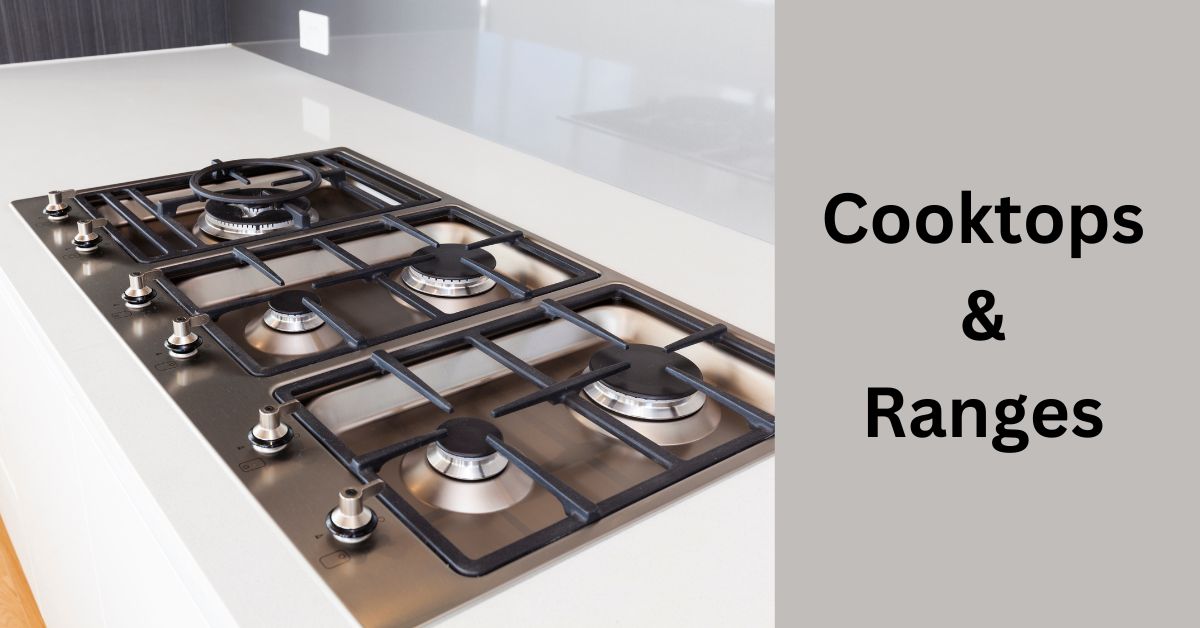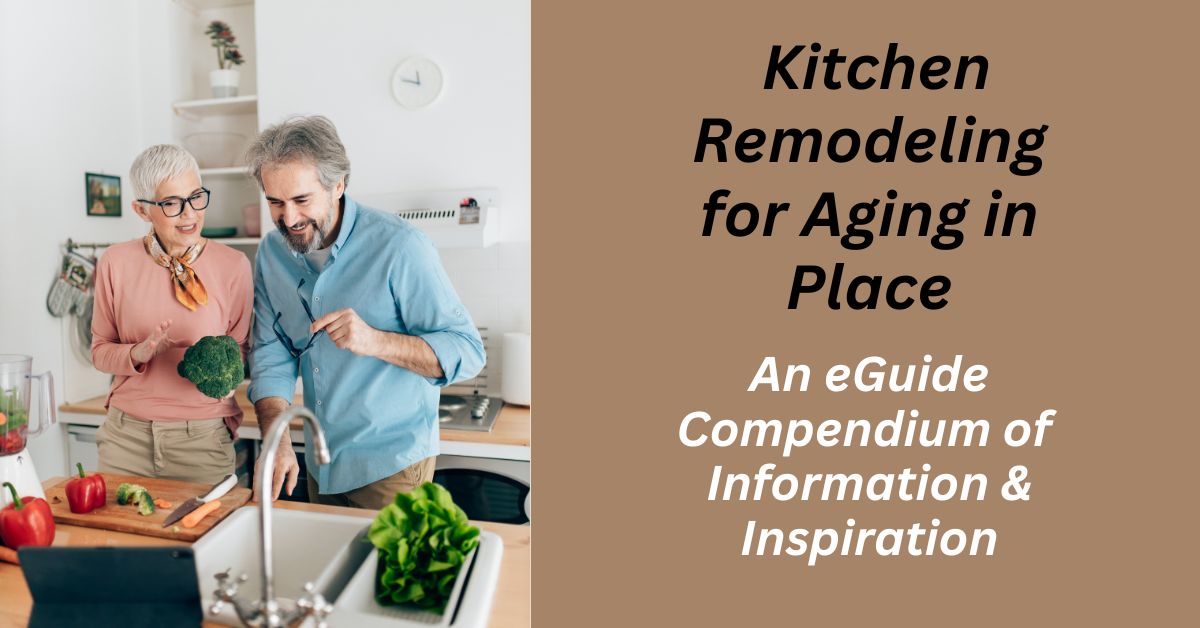Table of Contents
Note: If you came to this post on cooktops and ranges through a random search, please click on this parent page and our home page for more context.
The Language of Cooktops and Ranges
There is sometimes a great deal of confusion about terms when we get to discussing cooktops and ranges. So, before we get going on our analysis, we thought we’d spend a few moments getting a few definitions straight.
Difference Between a Cooktop and a Range?
A range is a kitchen appliance that combines both an oven and a cooktop in a single unit. Until recently, this has been the standard for most kitchens. But now and often, the cooktop has become divorced from the oven and placed separately within the kitchen.
If you are remodeling your kitchen, there are good reasons for choosing a separate cooktop and wall oven arrangement over the standard all-in-one range.
Difference Between a Range and a Stove?
This is really the same as the first question when we understand that “stove” and “cooktop” are the same thing. The 4 to 6-burner stove (aka cooktop) is placed on top of the oven to form the standard range.
Why are Stoves Called Ranges?
Because the stove (aka cooktop) is part of the range. The word “range” itself means a row or series of things. So the combination of an oven with several cooktop burners offers the chef multiple (or a “range” of) cooking opportunities.
What is a Hob?
“Hob” is British English for cooktop or stove. The word sometimes comes up in an American context and adds to the confusion.
What are the Four Basic Types of Cooktops?
There are four types of cooktops. These are the gas cooktop, the electric cooktop, the induction cooktop, and the range top.
The first three are regular cooktops designed to drop into a recess on the countertop. Their controls are on the top horizontal surface adjacent to the cooking area.
However, the range top, which is typically gas, slides into the counter all the way to the wall. It has its controls on the front vertical surface. This is in the same style as the controls of a cooktop on the standard range
Cooktop and Range Comparisons
We now get into comparing the various range and cooktop options.
But first, let’s say that there are many excellent choices out there. And so much of this has to do with personal preference, kitchen design options, and budget.
As to preference, the hard-core cooking enthusiast may simply refuse to cook on anything but gas.
As to price, the straightforward range (cooktop + oven combo) will almost always be the most economical choice. And in the case of a small kitchen, it may be the only sensible design choice.
But just a quick note about product and price in the context of a home remodel or renovation project. Take a moment to think about how long you will be living with your selection!
Within reason, it’s not the price of a product that matters so much as its suitability and durability. These add up to real value, provided the price is not excessive.
Range and Cooktop Installation – Pro Tips
- During the remodeling process, Install a pot filler faucet near the cooktop or range.
- An easy way to make a cooktop accessible is to install cabinet doors below it. The doors can be opened to help a wheelchair user. It is a good idea to incorporate this in an aging-in-place project.
Rangetop vs Cooktop for Your Remodel Project
In laying out your new kitchen you have a choice on one hand between a standard range, which combines a cooking surface and oven in one unit. On the other hand, you are looking at a separate cooktop and separate oven.
- Related post: Kitchen Remodel Overview & Checklist
- Related post: Kitchen Layout
Here is why you might prefer the cooktop over the range
Safety: The cooktop is safer than a range because it cools off faster. And in the case of the induction cooktop, the surface does not heat up at all. Safety is an important consideration if you are remodeling with aging in place in mind.
Convenience: With a cooktop, you get a much easier transition from the cooking area to the countertop. Plus the cooktop can even double as extra counter space when not being used for cooking.
Flexible design options: Cooktops can be installed at a variety of heights to suit the individual.
Since the cooktop is not connected to the oven below, it allows for a more flexible kitchen design. For example, you can have the cooktop on an island and a wall oven at a more manageable height within the cabinetry on a wall. This physical convenience is important, for example, in an aging-in-place application.
In our own design opinion, the cooktop makes the perfect partner for the swing door wall oven.
In sum, if you are remodeling your kitchen, whether fully or partially, there is a good reason to choose a cooktop combined with a separate wall oven over the standard all-in-one range.
While it is true that a separate cooktop and oven arrangement is more expensive than the standard range, in our opinion this is outweighed by the long-term functional benefits of the cooktop and wall oven combo.
Kitchen Ranges
Recognizing that for many people, the range may be the only option for kitchen design or budget reasons.
Note, however, that a range may be gas or electric-fueled.
For remodeling or renovation purposes, the width is the critical dimension and may be dictated to you by your kitchen layout. Other features are really a matter of personal preference.
Ranges on Amazon
Frigidaire Freestanding Electric Range
- 5 Elements, Smoothtop Cooktop
- 5 cu. ft. Primary Oven Capacity
Induction Cooktops
Turning now to cooktops, let’s start with induction cooktops since these are the least understood.
Some people have very strong preferences for the standard gas or electric cooktop. In fact, we know people who refuse to cook on anything but gas. However, we are big fans of the induction cooktop as being especially suited to an aging-in-place kitchen design.
- Related post: Kitchens for the Elderly
Induction Cooktop Safety
Here is an induction cooktop explainer on YouTube: The TRUTH About Induction Cooking
When you come to think of it, the regular electric or gas range or cooktop is the only part of the kitchen that uses exposed and therefore potentially dangerous heat. It stands in stark contrast to the oven, which is designed to keep the heat contained and insulate you from accidental harm.
So we welcome the induction cooktop. It uses electromagnetic technology to create the heat necessary to cook your food but without cooking your fingers. And it has other advantages too.
How do induction cooktops work?
The induction cooktop uses electric coils and magnets to create heat within ferrous metal cookware rather than underneath it. Below each of the glass cooktop cooking zones (they are not burners!) is an induction coil. When the coil is turned on, an electric current passes through it, creating an oscillating magnetic field.
The magnetic field induces (creates) small eddy currents within the ferrous metal cookware just above it. These currents have the effect of creating heat within the metal cookware and this, in turn, heats the food.
The surface of the cooktop remains relatively very cool. It is warmed by contact with the cookware only. This makes induction cooking very safe. You can safely touch the cooktop with your fingers when it is turned on.
This is the end of accidental burns from leaning over a hot stove and you have to wonder why exposed heat cooking devices are even allowed!
The induction cooktop is perfect for an aging-in-place application.
Advantages of Induction Cooktops
Aside from safety, induction cooktops have other advantages:
- The technology allows for precise cooking and cooks very evenly since the entire cooking vessel is heated and there are no hot spots under it (imagine a frying pan over a gas burner).
- It has a very fast high/low-temperature response, rivaling even gas.
- Because the cooktop surface is cool it is much easier to clean up spills on it.
- These cooktops are a functional and aesthetically sleek complement to cabinetry and countertops.
- As with any cooktop, it can be installed at a variety of heights and configurations.
Drawbacks of Induction Cooktops
- You can only use ferrous cookware. An easy test of this is to see if a magnet sticks to it. If it does, you are good to go.
- They can make an annoying humming sound
- They are relatively expensive
Induction Cooktops on Amazon
Radiant Electric Cooktops
Electric Cooktop vs Gas Cooktop – Which is Better?
In our opinion, it all comes down to cooking style preferences but there are specific differences to consider:
- A gas cooktop applies heat to the cookware instantly. Electric cooktops take a little while to reach the temperature you want.
- Due to the nature of the heat transfer, a gas cooktop generally heats more evenly. This is because the gas flame heats both the bottom and the sides of the cookware.
- Gas cooktops are more expensive to buy and install but less expensive to operate.
- A glass electric cooktop is much easier to keep clean than a gas cooktop.
- Electric cooktops are safer than gas cooktops simply because electricity is inherently safer than gas. And the induction cooktop is safer than the standard electric cooktop.
Electric Cooktop vs Induction Cooktop – Which is Better?
Both are powered by electricity but there are big differences.
The electric ceramic cooktop heats the cookware via radiant electric coil heating elements under the glass. Radiant means that this is heat that you can feel if you hold it over the cooktop.
The induction cooktop heats special ferrous cookware via high-frequency electromagnets instead of coil heating elements. The electromagnetic effect causes the cookware itself to heat and not the surface of the cooktop. Unless you touch the cookware, you can’t feel this heat.
As to which is better, in general, the induction cooktop is more expensive but more efficient. It is also considered safer since the only thing that gets hot is the cookware itself. However, for induction cooking, you do need (preferably) purpose-made ferrous cookware for it to work properly.
The induction cooktop is safer because the elements do not cause the surface of the cooktop to heat up. So in the case of a regular flat glass electric cooktop, unless there is a built-in heat warning light, there is nothing to alert you that the surface is hot. At least with a gas cooktop, you can see if there is a flame or not.
The induction cooktop is more efficient in its use of electricity. Also, unlike the regular electric element, there is virtually instant control of the amount of heat it generates within the cookware.
The induction cooktop is more expensive than the regular electric cooktop. And you are limited in the kind of cookware you can use. It must be ferrous. You can’t use glass or aluminum.
Radiant Electric Cooktops on Amazon
Gas Cooktops
Gas Cooktop vs Electric Cooktop – Which is Better?
Again, in our opinion, it all comes down to cooking style preferences but there are differences to consider:
- A gas cooktop applies heat to the cookware instantly. Equally, you can reduce the heat instantly. Electric cooktops take a little while to reach the temperature you want and they take time to cool. So gas gives you much better control. On the other hand, an induction cooktop (as distinct from a regular electric cooktop) gives you pretty much the same control as gas.
- The size of the gas flame gives you a visual idea of where the temperature is. You don’t get this with an electric element.
- Due to the nature of the heat transfer, a gas cooktop generally heats more evenly. This is because the gas flame heats both the bottom and the sides of the cookware.
- Gas cooktops can be more expensive to buy and install but they are less expensive to operate.
- A glass electric cooktop is easier to keep clean than a gas cooktop.
- Electric cooktops are safer than gas cooktops simply because electricity is inherently safer than gas.
- While electricity is universally available, a gas supply is not. So gas may not even be an option.
Gas Cooktop vs Induction Cooktop – Which is Better?
In the induction vs gas contest, let’s first establish the differences.
The gas cooktop heats the material of the cookware directly via flame and heat applied by the burners to its bottom and sides. The induction cooktop causes the ferrous cookware itself to get hot via high-frequency electromagnets instead of gas burners. The electromagnetic effect causes the cookware to heat but not the cooktop on which it sits.
As to which is more responsive, the gas and induction cooktops are about equal. They deliver the same ability to adjust the heat.
As to which is better, in general, the induction cooktop is more expensive but more efficient. It is also considered safer since the only thing that gets hot is the cookware itself. This is aside from heat radiated from the cookware back to the cooktop surface but which cools off fast. However, for induction cooking, you must use flat-bottomed ferrous cookware for it to work at all. If a magnet sticks to your cookware, it is ferrous and you are good to go. But you can’t use a regular round-bottomed wok.
If you like to cook with a wok, then gas is your best bet. You can’t use a wok on an induction cooktop.
And then there is the preference for cooking style. Some people just prefer to cook with gas.
Do Chefs Prefer Gas or Induction?
There was a time when no self-respecting chef would cook on anything but gas. But now many of them are converting over to induction cooking and swearing by it. Here are some of the reasons:
- Easier to clean down after use
- Much faster to cook with induction and you can increase or lower the temperature much more quickly.
- Provides much more precise control of the heat.
- Keeps the kitchen much cooler because the heat is pretty much confined to the cookware
Gas Cooktops on Amazon
Rangetops
As noted earlier, the range top is similar to a gas countertop unit but with its controls along the front vertical edge, in the same style as the cooking surface on a standard range.
While the regular cooktop is dropped into a cutout in the kitchen counter, the rangetop is built into the upper cabinetry and extends from the wall to the front of the cabinetry
Which is Better, Rangetop vs Cooktop?
Here are the main differences to help you decide.
- While the cooktop can be gas, electric, or induction, the range top is almost always gas.
- The range top takes up more cabinet space than the cooktop.
- The controls of the range top are in front and within reach of children. The controls of the cooktop are out of reach of children.
- There is typically more cooking room on a range top than on a cooktop.
- A range top produces more cooking BTU than a cooktop.
- The range top tends to be more expensive than the cooktop.
Rangetops on Amazon
Range & Cooktop FAQs
How do you clean a glass electric or induction cooktop glass?
The single biggest downside to the glass cooktop (probably the only one) is keeping it clean. We suggest the Cerama Bryte cooktop glass cleaner.
If anything gets caked onto the glass, then here is Plan B:
- First, get a razor blade-type metal scraper and gently lift the crud off the surface of the glass.
- Then use the Cerama Bryte cleaning kit to follow up.
- Finish with a soft microfiber cloth.
But there is another (old school) way to clean it with stuff that is usually on hand:
- Once the heating elements have cooled, spray the glass surface with white vinegar and then wipe it with a damp cloth.
- Next, sprinkle baking soda on the glass. This will help break down the crud on the glass. It is only slightly abrasive and rubbing will not harm the glass surface.
- Then, soak an old towel in water, spread it over the glass and baking soda, and pat it down. Let it sit there for 20 minutes or so.
- Then rub the glass with the towel to remove the loosened crud. Rinse the towel and repeat this step a couple of times if necessary
- Then, if there is any stuck-on crud remaining, take a razor blade and carefully lift it off.
- Finally, repeat the first step with vinegar and then polish with a dry cloth.
This is obviously a rigmarole. But you can avoid it just by staying on top of your cleaning. Plain old Windex can help you do this.
How do you care for electric cooktop glass?
Before using the cooktop for the first time, prepare it by using a glass cooktop cleaning cream. We mentioned Cerama Bryte earlier but you should also consider Weimans. You can find this in most supermarkets or hardware stores. These creams leave a protective film on the glass and help prevent accidental scratching. Then just take some common sense precautions like:
- Cleaning up spills immediately.
- Not scraping metal objects over the surface. This means placing your cookware on it, not sliding it.
- Not letting crud build up on the bottom of the cookware.
- Not using it as a cutting surface.
- Not dropping heavy objects on it.
From time to time re-apply the glass cooktop cleaning cream.
How do you compare stainless steel and porcelain enamel gas cooktops?
So far as aesthetic appearance goes, this is simply a matter of personal preference. In our opinion, while we are used to seeing stainless steel on the vertical surfaces of, say, a refrigerator, it looks great on a horizontal surface too.
As to ease of cleaning, it is probably a toss-up between the two but with a slight edge in favor of the enamel cooktop.
As to durability, porcelain enamel can chip if something sharp or heavy gets dropped on it. While this can be repaired with something like black PorcAFix, the enamel finish will never be quite the same. So in this respect, the edge goes to the stainless steel.
So the ultimate decision between the two is your own preference for aesthetic appearance.
How do you clean a stainless steel cooktop?
a: Go with the grain:
It may come as a surprise but stainless steel actually has a grain. However, it is not as obvious as the grain in wood. So here’s how to find it.
If you look closely you should be able to see faint lines running along the surface of the steel. That is the grain. If the lines are too faint to see, take a soft cloth and rub it hard over the surface of the stainless steel in a horizontal and then vertical direction.
You will find that it is easier to rub in one direction than the other. When you have found the easier direction, you have found the direction of the grain.
Nothing bad will happen if you clean against or across the grain. But tiny amounts of cleaning residue will be left behind in the little crevices and this will reduce the shine of the stainless steel.
b: Cleaning products to use:
You can try the purpose-made Magic Stainless Steel Cleaner Aerosol.
And here are other old-school cleaning methods that are safe to use on your stainless steel cooktop and are usually on hand:
- Baking soda and vinegar – These will remove crud and grease.
- Olive oil and vinegar – Spray the vinegar directly onto the stainless steel. Follow up with a cloth dipped in olive oil.
- WD-40 – Does a great job cleaning the stainless steel but don’t let it get onto any food prep surface.
- Warm distilled water and a microfiber cloth.
- Dish soap and distilled water.
- Lemon oil furniture polish is applied with a microfiber cloth.
- Windex – It works well on stainless steel as well as glass.
c: Do not use these cleaning methods, which can harm your stainless steel cooktop:
- Steel wool – This will scratch and dull the surface.
- Hard tap water – The minerals in the water will cause streaks on the stainless steel surface.
- Abrasive bathroom or kitchen cleaning products – These will scratch the stainless steel surface.
- Bleach-based cleaners – Chlorine can discolor stainless steel.
Oven cleaners – These can damage the stainless steel finish.
What does “sealed gas burner” mean?
There are no open gaps in the cooktop for spills to seep into.
36-inch cooktop vs 30-inch cooktop – Which should I go for?
If you don’t have space for a 36-inch unit, then the 30-inch unit is your only choice.
However, if you have space, go for the 36-inch unit. Here are three reasons:
- If you have a ton of counter space, a 30-inch unit would not be in proportion and would look awkward in the space.
- The 36-inch unit has a greater cooking capacity and you will certainly welcome this for entertaining.
- The 36-inch unit would add greater resale value, not least because of the added “wow” effect.
In other words, it is a false economy to opt for the 30″ cooktop when a 36″ unit can be accommodated.
Can the induction cooktop surface scratch?
Yes, it is glass. But you can use Silicone Fiberglass Induction Cooktop Mats under the cookware to prevent scratching without affecting the electromagnetic heating action. This will also stop the cookware from sliding around on the glass surface.
What is the difference between a glass cooktop and a ceramic cooktop?
There is none. Apparent differences are all in the marketing of individual brands. The material used to form the smooth flat-top cooktop surface is basically the same.
None of the smooth cooktops on the market is all-ceramic or all-glass. Rather, they are all made from a blend of glass and ceramic material known in the industry as CERAN®.
- Related post: Range Hoods
- Related post: Kitchen Feng Shui
- Related post: Oven Selection















Leave a Reply